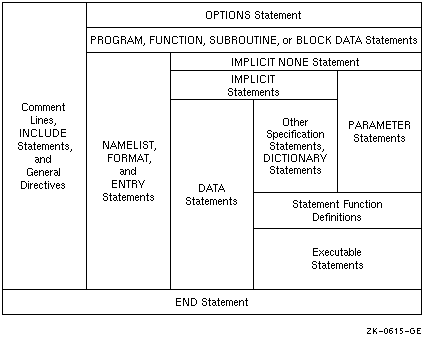
Program statements are grouped into two general classes: executable and nonexecutable. An executable statement specifies an action to be performed. A nonexecutable statement describes program attributes, such as the arrangement and characteristics of data, as well as editing and data-conversion information.
A statement is divided into physical sections called lines. A line contains up to 72 characters (with a compiler option, 132). If a statement is too long to fit on one line, it can continue on one or more additional lines called continuation lines. A continuation line has a continuation character in the sixth column of the line.
A statement label identifies a statement so that other statements can refer to it, either to get information or to transfer control. A statement label must be one to five digits long, at least one of the digits must be nonzero, and it must appear in the first five columns of a statement's initial line. Any statement can have a label. However, you can only refer to labels of executable statements and FORMAT statements.
Order of Statements in a Program Unit
Figure 1-1 shows the required order of statements in a Fortran program unit. In this figure, vertical lines separate statement types that can be interspersed. For example, you can intersperse DATA statements with executable statements.
Horizontal lines indicate statement types that cannot be interspersed. For example, you cannot intersperse statements in the category "Other Specification Statements" (such as type declaration statements) with "Executable Statements".
Some of the general directives included in the category of "Comment Lines, INCLUDE Statements and General Directives" in Figure 1-1 apply to all platforms, but some are platform-specific.
The following general directives apply to all platforms:
| cDEC$ ALIAS | cDEC$ SUBTITLE |
| cDEC$ IDENT | cDEC$ TITLE |
| cDEC$ PSECT |
The following general directives are platform-specific:
| Directive | Platform |
| cDEC$ ASSERT | VAX only |
| cDEC$ INIT_DEP_FWD | VAX only |
| cDEC$ NOVECTOR | VAX only |
| cDEC$ OPTIONS | Alpha only |
Many of the statements included in the category of "Executable Statements" in Figure 1-1 apply to all platforms, but the executable directives and some of the statements are platform-specific.
The following executable statements apply to all platforms:
| ACCEPT | IF[2] and END IF |
| ASSIGN | INQUIRE |
| Assignment statements | OPEN |
| BACKSPACE | PAUSE |
| CALL | |
| CLOSE | READ |
| CONTINUE | RETURN |
| DELETE | REWIND |
| DO and END DO | REWRITE |
| ELSE | STOP |
| END | TYPE |
| ENDFILE | WRITE |
| FIND | UNLOCK |
| GO TO[1] | |
|
[1] Normal, computed, and assigned
| |
The following executable directives and statements are platform-specific:
| Statement or Directive | Platform |
| cPAR$ DO_ PARALLEL | VAX only |
| cPAR$ LOCKOFF | VAX only |
| cPAR$ LOCKON | VAX only |
| CASE | Alpha only |
| CASE DEFAULT | Alpha only |
| CYCLE | Alpha only |
| EXIT | Alpha only |
| SELECT CASE | Alpha only |
| END SELECT | Alpha only |
Many of the statements included in the category of "Other Specification Statements" in Figure 1-1 apply to all platforms, but the specification directives and some of the statements are platform-specific.
The following specification statements apply to all platforms:
| AUTOMATIC | RECORD |
| COMMON | SAVE |
| DIMENSION | STATIC |
| EQUIVALENCE | Structure declarations[1] |
| EXTERNAL | Type declarations |
| INTRINSIC | VOLATILE |
| POINTER | |
|
[1] Structure declarations include STRUCTURE and END STRUCTURE, UNION and END UNION, and MAP and END MAP. | |
The following specification directives and statements are platform-specific:
| Statement or Directive | Platform |
| cPAR$ CONTEXT_SHARED | VAX only |
| cPAR$ CONTEXT_SHARED_ALL | VAX only |
| cPAR$ PRIVATE | VAX only |
| cPAR$ PRIVATE_ALL | VAX only |
| cPAR$ SHARED | VAX only |
| cPAR$ SHARED_ALL | VAX only |
| DICTIONARY | VMS only |
As an extension, DATA statements can be freely interspersed with PARAMETER statements and other specification statements.